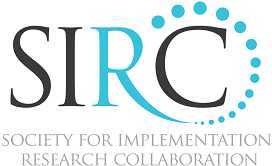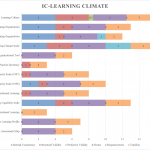| A climate in which leaders recognize team members’ value, team members feel valuable and free to try new methods, and there is sufficient
time and space for reflective thinking and evaluation (in general, not just in a single implementation). |
|
| Implementation Climate: Learning Climate | |
|
To see the head-to-head comparisons of the evidence-based assessment rating profiles for the instruments listed below, please click here. |
|
|
Continuous Learning Culture (CLC) Tracey et al. (1995) |
|
| The Continuous Learning Culture scale is 24-item instrument that measures perceptions, beliefs, expectations, and values that reflect a broad range of individual, task, and organizational factors that support knowledge, skill, and behavior acquisition and application. | |
|
Dimensions of Learning Organization (Academic Version) (DLO) Marsick & Watkins (2003) |
|
| The DLO is a 62-item instrument that measures important shifts in an organization’s climate, culture, systems, and structures that influence whether individuals learn. | |
| Dimensions of Learning Organization Questionnaire (DLOQ)
Yang et al. (2004) |
|
| The DLOQ is a 21-item instrument that determines theoretical relationships of the learning culture and other variables such as organizational performance, transfer of learning, and organizational capability. | |
| General Training Climate Scale (GTCS)
Tracey & Tews (2005) |
|
| The General Training Climate Scale (GTCS) is a 15-item instrument used to measure perceived support from management, work, and the organization for formal and informal training and development activities. | |
| Learning Organizational Tool (LOT)
Garvin et al. (2008) |
|
| The Learning Organization Tool is a 55-item instrument that assesses the extent to which an organization is a Learning Organization (LO), a conceptual framework built upon a supportive learning environment, concrete learning practices and processes, and leadership that reinforces learning. | |
| Learning Practice Inventory (LPI)
Kelly et al. (2007) |
|
| The Learning Practice Inventory is a 66-item diagnostic instrument designed to identify a practice’s capacity for collective learning and change. | |
| Organizational Learning (OL)
Templeton et al. (2002) |
|
| The Organizational Learning questionnaire is a 36-item instrument that uses a five-point Likert scale to ask organizational leaders their views on how well their organization performs in terms of operations, employees, and management. | |
| Organizational Learning Capability scale (OLC)
Chiva et al. (2007) |
|
| The Organizational Learning Capability Scale is a 14-item instrument based on a comprehensive analysis of the facilitating factors for organization learning; it aims to capture the organizational propensity to learn. | |
| Organizational Learning Capacity Scale (OLCS)
Hult, Ferrell (1997) |
|
| The Organizational Learning Capacity Scale is a 23-item instrument that assesses organizations in terms of organizational learning activities and relationships, the value placed on organizational learning, and the accessibility of organizational knowledge. | |
| Organizational Learning Survey (OLS)
Goh & Richards (2007) |
|
| The Organizational Learning Survey is a 21-item instrument used to measure the five major theoretical underlying organizational characteristics and management practices that facilitate organizational learning. | |
| Phases of Organizational Learning (POL)
Chen (2006) |
|
| The Phases of Organizational Learning is a 33-item instrument used as a representation of the range of possible relationships between organizational learning and evaluation. | |
| School Success Learning Profile (SSP-LO)
Bowen et al. (2007) |
|
| The School Success Learning Profile is a 36-item instrument that measures the functioning of schools as learning organizations. | |
| Strategic Learning Assessment Map (SLAM)
Bontis et al. (2002) |
|
| The Strategic Learning Assessment Map is a 70-item instrument that assesses five theoretical constructs: three learning stocks- individual, group and organization; and two learning flows- feed-forward and feed-back. |
Disclaimer: Some instrument descriptions were taken directly from articles contained in specific instrument pages.

